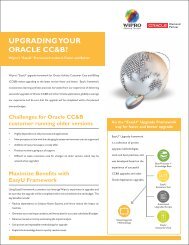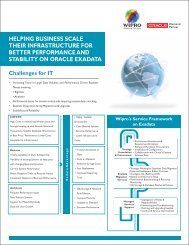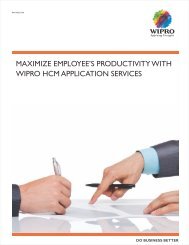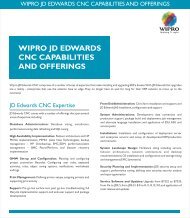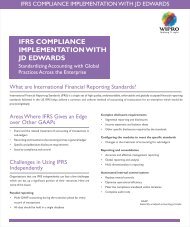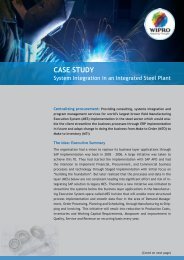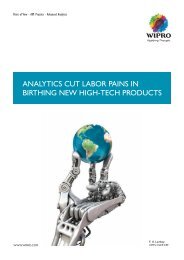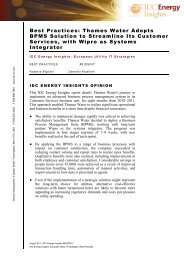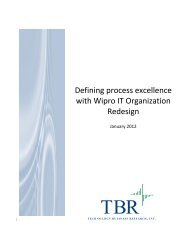DARK POOLS OF LIQUIDITY
DARK POOLS OF LIQUIDITY
DARK POOLS OF LIQUIDITY
Create successful ePaper yourself
Turn your PDF publications into a flip-book with our unique Google optimized e-Paper software.
<strong>DARK</strong> <strong>POOLS</strong> <strong>OF</strong> <strong>LIQUIDITY</strong><br />
Understanding & Technology dependencies for the future<br />
This whitepaper throws light over dark pools trading & the<br />
benfits of dark pool trading for institutional investors<br />
mainly. It also focusses on variuos types of dark pools in<br />
the market today and how the trading process is different<br />
as compared to the traditional exchange trading.<br />
Institutions Point-of-view:<br />
This paper also aims at coming up with the<br />
investors point of view on technology applicable and what<br />
could revolutonalize this trading mechanism in the future<br />
with more and more institutions like mutual funds,<br />
pension funds, hedge funds turning to this mechanism for<br />
liquidity<br />
Technology firms Point-of-view: This paper also throws light on what could be several<br />
technology companies’ startegies towards this growing market and how they can allign their<br />
offerings to these customers and improve business revenues and their shareholder value.<br />
Overall, this paper is targetted at an audience who is looking to gain an insight into the dark<br />
pools of liquidity and looking to understand the mechanism of dark pools trading, advantages<br />
and how technology would impact the operations or provide benefits in trading over this<br />
medium. Also provides the authors view point on the future of dark pools of liquidity, their<br />
existance and how oversight needs to change to be able to create a competitive market space.<br />
Understanding & Technology dependencies for the future<br />
RAVIKIRAN ACHUTHAKUMAR<br />
Business Analyst, Wipro Technologies
Table of Contents<br />
Dark pools of liquidity 2009<br />
DEFINITIONS & INTRODUCTION ................................................................................................................................ 3<br />
WHY ARE THEY REQUIRED? ..................................................................................................................................... 4<br />
TYPES <strong>OF</strong> LIQUID <strong>POOLS</strong> .......................................................................................................................................... 5<br />
EXCHANGE TRADING (VS) <strong>DARK</strong> POOL TRADING ....................................................................................................... 6<br />
HOW DO THEY IMPACT THE CURRENT MARKET? ....................................................................................................... 9<br />
FRAGMENTED MARKETS PERSPECTIVE TO <strong>DARK</strong> <strong>POOLS</strong> ............................................................................................. 9<br />
TECHNOLOGIES THAT CATER TO THIS INDUSTRY NEEDS ........................................................................................... 11<br />
S<strong>OF</strong>TWARE VENDORS CAN HAVE SOLUTIONS & <strong>OF</strong>FERINGS ...................................................................................... 11<br />
KEY RISK MANAGEMENT INITIATIVES IN THE <strong>DARK</strong> POOL ARENA ............................................................................. 11<br />
CONCLUSION & WAY FORWARD >> ........................................................................................................................ 12<br />
Page2
Definitions & Introduction<br />
Dark pools of liquidity 2009<br />
“Dark Pools of Liquidity“ a slang term that refers to the trading volume<br />
created from institutional orders, which are unavailable to the public. Also referred<br />
to as the "upstairs market" which allows buyers and sellers to specify block trades<br />
facilitated away from the central exchanges.<br />
When a trade in a listed stock is not executed through the listing exchange, rather done over a<br />
computerized financial trading methods that use peer to peer networks (crossing networks instead of<br />
traditional central clearing hubs) to hide trades. This gives an advantage to those trading and a<br />
disadvantage to those outside of the trade.<br />
The dark pool gets its name because details of these trades are concealed from the public, clouding the<br />
transactions like murky water. Dark pools of liquidity (also dark pools or dark liquidity) are crossing<br />
networks that provide liquidity that is not displayed on order books. This is useful for traders who wish to<br />
move large numbers of shares without revealing themselves to the open market<br />
Agenda<br />
for Paper<br />
Dark pools are similar to what the NYSE was before it became an<br />
automated market.<br />
Recently, more than 20% of all trades in New York Stock Exchangelisted<br />
stocks have been funneled through these dark pools, up from<br />
just 3% to 5% two years ago, according to NYSE figures.<br />
"Exchanges are beginning to look a lot more like ATS's (alternative<br />
trading systems, or dark pools), while ATS's are looking more like<br />
exchanges."<br />
This whitepaper throws light over dark pools trading & the benfits of dark pool<br />
trading for institutional investors mainly. It also focusses on variuos types of<br />
dark pools in the market today and how the trading process is different as<br />
compared to the traditional exchange trading.<br />
Institutions Point-of-view :This paper also aims at coming up with the<br />
investors point of view on technology applicable and what could revolutonalize<br />
this trading mechanism in the future with more and more institutions like mutual<br />
funds, pension funds, hedge funds turning to this mechanism for liquidity<br />
options.<br />
Technology firms Point-of-view: This paper also throws light on what could be several technology<br />
companies’ startegies towards this growing market and how they can allign their offerings to these<br />
customers and improve business revenues and their shareholder value.<br />
Overall, this paper is targetted at an audience who is looking to gain an insight into the dark pools of<br />
liquidity and looking to understand the mechanism of dark pools trading, advantages and how technology<br />
would impact the operations or provide benefits in trading over this medium. Also provides the authors<br />
view point on the future of dark pools of liquidity, their existance and how oversight needs to change to be<br />
able to create a competitive market space.<br />
Page3
Why are they required?<br />
Dark pools of liquidity 2009<br />
Liquidity in standard financial markets is often openly advertised in order to attract additional liquidity<br />
to that venue and is usually done in real time by publishing market depth.<br />
Darl pools of liquidity arises from traders’ concern that if they clearly indicate their intention to buy<br />
large amount of a particular stock, they will drive the price of that stock up ahead of their trade, therby<br />
not be able to take up a competitive position in the market.<br />
The standard structure of a market place is as shown below with various participants<br />
Dark pools of liquidity has been around for a long time in the form of orders represented by floor brokers<br />
on the trading floors of the NYSE and the other exchanges<br />
Some of the main reasons for dark pools trading are as listed below;<br />
1. Trades can be processed anonymously, without impacting the price<br />
2. Dark liquidity is generally used to try and reduce market impact when trading large orders<br />
3. Dark liquid pools are becoming the execution destination of choice for increase number of buyers<br />
and sellers because of their increased liquidity nowadays and also able to provide lower<br />
transaction costs while providing anonymity of the trader.<br />
4. Dark pools of liquidity have existed for some time, but it is now that technology has made it easier<br />
to access them - the value of accessing as much liquidity as possible has been understood.<br />
5. Dark pools offer flexibility to customers and are particularly popular with brokers who use<br />
computer-executed strategies<br />
6. More recently, dark pools also make it easier to trade small- or mid-cap stocks, which are often<br />
lower-profile companies that, because they're less liquid, are harder to trade publicly.<br />
Fragmentation in the market has formed a lot of ‘dark pools’ of liquidity, which can only be accessible<br />
through electronic means and Algo trading is making the most of them possible.<br />
Page4
Types of Liquid Pools<br />
Dark pools of liquidity 2009<br />
Over the years the dark pools have evolved based on localization with respect to different brokerage<br />
houses and other investor’s likings. Several institutions developed propreitery platforms in order to enable<br />
trade trough this methodology and seek the desired benefits of trading large orders with anonmity.<br />
Dark pools can be classified on 4 types - that are competing in the market as of today;<br />
Highlights: (figure 1)<br />
• Independent platforms<br />
• Broker-dealer internal matching engines<br />
• Consortium-led pools, and<br />
• Exchange-crossing networks<br />
Instinet<br />
Popular Independent dark pools<br />
Investment Technology Group (ITG)<br />
Liquidnet<br />
NYFIX Millennium<br />
Pipeline Trading Systems<br />
Pulse Trading<br />
Firms engaged in dark liquid pools<br />
BNY ConvergEx Group (an affiliate of Bank of New<br />
York Mellon)<br />
Citi Markets and Banking<br />
Credit Suisse<br />
Fidelity Capital Markets Services<br />
Goldman Sachs Execution and Clearing<br />
Knight Capital Group<br />
Lehman Brothers<br />
Merrill Lynch<br />
Morgan Stanley<br />
UBS Investment Bank<br />
Fig 1<br />
Exchange-owned dark pools<br />
International Securities Exchange<br />
The NASDAQ Stock Market<br />
NYSE Euronext<br />
Direct Edge<br />
Consortium-owned dark pools<br />
BIDS Trading<br />
eBX LLC<br />
Exchange-owned dark pools<br />
International Securities Exchange<br />
The NASDAQ Stock Market<br />
NYSE Euronext<br />
Direct Edge<br />
Chi-X<br />
Mismi<br />
Other dark pools<br />
Page5
Exchange trading (vs) Dark pool trading<br />
Dark pools of liquidity 2009<br />
Let’ s us quickly understand the normal trading process that takes place in an ideal market scenario in<br />
order to see the difference and benefits that the dark pool trading offers to large investors.<br />
Trading over the exchange:<br />
The figure below depicts the normal trading process and different points of handshake between<br />
middlemen & institutions that make a trade possible and help investors in their transactions of securities/<br />
scrips<br />
Trader<br />
Illustration Scenario:<br />
Process Flow of orders – Normal Scenario<br />
Displayed Order<br />
Depository<br />
Systems<br />
BUY<br />
ORDER<br />
Algorithms<br />
Platforms<br />
ECN / ATS / EB<br />
Regulator<br />
Clearing House<br />
Custodians<br />
Registrar<br />
SELL<br />
ORDER<br />
Algorithms<br />
Platforms<br />
Displayed Order<br />
Others<br />
Cash<br />
Accounting<br />
Client<br />
Clearing Bank<br />
Systems<br />
ECN – Electronic Communication Networks<br />
ATS – Alternative trading systems<br />
EB – Executing brokers<br />
In an ideal scenario, when a trader would like to either buy/sell shares over the exchange, there are a<br />
series of interaction with various parties involved in the completion of the trade between the 2 parties.<br />
Below are a few steps that are essential to every trade transaction that happens over the exchange.<br />
1. The trader who would like to buy/sell the security would call his broker and place an order to<br />
buy/sell the securities at a willing /expected price.<br />
2. The authorized broker would then place the order over the exchange through the electronic<br />
systems.<br />
3. Once the order gets accepted, a contract note / electronic confirmation provided to the trader.<br />
4. Trade details from the exchange is then passed to the clearing house<br />
Page6
Dark pools of liquidity 2009<br />
5. The clearing members provide the information to custodians; based on the acknowledgement<br />
they identify the obligations.<br />
6. Instructions for clearing banks / depositiries to submit the funds/securities – pay in<br />
7. Pay out of funds and funds to appropriate parties takes place<br />
8. Depositories and clearing banks provide information to their respective parties.<br />
The above cycle of activites happen for each and every trade over the regular market scenario.<br />
Trading Over Dark pools<br />
Now, let’s quickly understand the process of trading over dark pools. Once we see the trading cycle we<br />
shall be able to compare the 2 trading processes and be able to understand the difference and benefits<br />
derived by large volume traders. The below diagram indicates the trading cycle over dark pools.<br />
Trader<br />
Others<br />
Non-Disclosed Order<br />
Cash<br />
Accountin<br />
g<br />
Illustration Scenario:<br />
Crossing Networks<br />
Depository<br />
Systems<br />
Clearing Bank<br />
Systems<br />
Trading Over Dark Pools<br />
BUY<br />
ORDER<br />
Dark pool of Liquidity<br />
•Independent Platforms<br />
•Broker Dealer platforms<br />
•Consortium led pools<br />
•Exchange crossing<br />
networks<br />
Brokerage House<br />
Custodians<br />
Registrar<br />
SELL<br />
ORDER<br />
Non-Disclosed Order<br />
Crossing Networks<br />
Benefits Derived Through Dark<br />
Pool Trading<br />
More Anonymity & Rapid Exec<br />
Reduced Transaction cost<br />
Reduced Market Impact<br />
More Liquidity than public<br />
markets<br />
• The trader who would like to buy/sell the security would call his broker or place an order over the<br />
electronic system of the broker to buy/sell the securities at a willing /expected price.<br />
• The broker then interalizes the order and looks for suitable matches within his network - by<br />
breaking the orders into smaller pieces, computer programs match and execute the different<br />
segments of the order in hundreds of separate transactions<br />
• The transaction details are then informed to the other parties concerned – depository and<br />
custodians for the clearing and settlement to take place.<br />
• The confirmation of the trade and trade details are then provided to the 2 parties.<br />
Therefore, Dark pools, by contrast, do not alert the market makers that a sizeable order has been placed.<br />
In the process, information about the trader / institution's intent to sell would not leak out to other traders.<br />
Therefore, the shares would not be under pressure, and the seller would end up receiving more money for<br />
his stock by exiting at the current price.<br />
Client<br />
Page7
Dark pools of liquidity 2009<br />
Flipside to the dark pool is that there is little way for sellers to assess whether they have received the best<br />
possible execution on the order, especially the case if the broker has "internalized" the order – i.e. match<br />
the order within their own shops, operating beyond the vision of other dealers and outside the spotlight of<br />
the SEC and use of technology / development of crossing networks has greatly expanded the in-house<br />
opportunities and through this we can observe a consolidation in the brokerage industry.<br />
The trading process over the dark pool is very highly dependent on information availability, accuracy of<br />
data and lead times between order and delivery - this can be abridged only through the use of<br />
teachnology. Technology if used positively can play to a trader’s advantage in seeking benefits through<br />
dark pool trading.<br />
Technology Existance:<br />
The below diagram indicates how technology plays an important role in this different trading mode; The<br />
strategy server indicated connects with various broker networks enabling it to accept requests from<br />
various broker dealer networks and compare and match orders within.<br />
Alternate Trading Systems (ATS) include crossing networks, such as independently owned Liquidnet and<br />
Pipeline that match orders for execution without having to first route them to an exchange or market<br />
center where they could be viewed publicly. Besides enabling investors to execute an order without<br />
affecting the public price quote, crossing networks match orders at a specified price, typically the midpoint<br />
of the bid and ask prices on stocks at the point in time of the trade. Electronic communications networks<br />
(ECNs), which trade stocks and currencies, are another type of ATS.<br />
Firms such as Goldman Sachs, Morgan Stanley, Charles Schwab and others have giant order flows -<br />
They are obviously best positioned to fill orders in-house. They profit off a spread between the price they<br />
paid for a stock and the price they charge the buyer. While initially they are likely to seek narrow spreads<br />
so as to attract business, if there is a fall-off in the number of competitors, the spreads will likely widen<br />
Page8
Dark pools of liquidity 2009<br />
Table below indicates different broker dealer owned dark pool networks that are operational;<br />
How do they impact the current Market?<br />
A number of market center and major brokerage firms are engaging in transactions of large bulk orders<br />
through efficient transaction modes like ECN’s and benefiting through anonymity and lower transaction<br />
costs and also at the same time not impacting the market position.<br />
It is observed that strategic dark pool routing can provide for more efficient and potentially more profitable<br />
trading with minimal impact to Market prices without sacrificing anonymity.<br />
Therefore, with more and more brokerage houses and other institutional investors taking the dark pool<br />
trading model when it comes to large blocks, the actual liquidity in the market could get impacted and<br />
trading volumes could get lower by the day in the exchanges. This would start affecting the market<br />
liquidity position slowly and could call for serious consideration towards the volumes that could be traded<br />
over these dark pools. As a result there could be fragmentation in the market with the growing popularity<br />
of these dark pools.<br />
Fragmented Markets perspective to dark pools<br />
Dark pools would in turn bring in fragmented markets as feared by most members.<br />
Page9
Dark pools of liquidity 2009<br />
In order to counter this the regulatory changes by the way of REG NMS brought in that any ATS that<br />
controls more than 5% of the daily average volume of a particular security over 4 of the preceding six<br />
months period must provide open quotes to the market.<br />
But dark trading pools, allow market participants to take a position on a stock without expressing it in the<br />
public, transparent stock markets. And, since these markets are not regulated, and therefore not<br />
transparent, insider trading seems likely.<br />
And even without insider trading, participants in dark pools could be trading on information which is not<br />
available to the public markets. This would give rise to differences in price. Which would give rise to<br />
arbitrage opportunities.<br />
Point to wonder - could this have happened in the current Indian market scenario as well with investors<br />
losing high value over the last few months? Certain large investors exiting the markets leading to stock<br />
having steep falls in its price thereby viping out liquidity in the market<br />
Now,lets try and counter this problem and see if there is a work around to this - This situation could be<br />
resolved in one of three ways;<br />
One, the financial institutions that run dark pools will be true to their word and mark dark pool prices to the<br />
public markets at all times – this will be too much to expect of them.<br />
Two, this would give rise to opportunities that traders would be compelled to take advantage of dark<br />
pools, and in order to take advantage of these opportunities they would have to take positions in public<br />
markets, which would then mean, theoretically, brings the black pool information to the public prices. If<br />
this process happened quickly enough, the difference in prices between the two markets would be<br />
arbitraged away.<br />
Third outcome to this situation, that prices remain different between the two markets for significant periods<br />
of time.<br />
In above cases either the public or the private market would be right about the direction in price, but<br />
certainly not both, and someone would lose money. And one would assume (although it’s certainly not<br />
guaranteed to be true), that dark pools would have the better information, since dark pools are only open<br />
to the privileged (i.e. better informed).<br />
Page10
Technologies that cater to this industry needs<br />
Dark pools of liquidity 2009<br />
Electronic Communication Networks (ECN’s) industries catering to transactions in dark liquid pools are<br />
active with consolidation and ever-changing competition. There have been several developments and<br />
acquisition in this space to reach out to those clients interested in such requirements. Today ECN’s are<br />
routing to their orders towards other ECN’s and exchanges making the trading space more wider and<br />
thereby enabling higher reach with reduced costs of transaction.<br />
Firms are accessing dark pools via point to point connections by means of managed network partners<br />
enabling them to access multiple dark pools simultaneously and also eliminate multiple connections.<br />
Software vendors can have solutions & offerings<br />
Some service lines that can relish working on dark pools; In the near future technology companies will<br />
have significant role to play in enabling more & more players entering this space in search of more<br />
liquidity. Some areas that may utilize immediately attention of software services are listed below;<br />
Technology Infrastructure Services –<br />
Ł Services like improve hardware utilization, storage management, physical server consolidation,<br />
Ł Increased availability of data & lowering data center operating costs, Identity and access mgmt.<br />
Ł Upgrade of existing systems for improved performance and reduced downtimes<br />
Application Development & Maintenance & Testing –<br />
Ł Trade matching engines, market data systems, reference data systems<br />
Ł Development of order routing / matching engines etc…application rationalization<br />
Ł Algo trading systems & mactching & reconcilliation systems,<br />
Technologies -<br />
Ł Web services / SOA, XML, server Virtualization (Vmware),<br />
Ł VoIP, network access controls, software as a service (SaaS),<br />
Ł Open source development, moving platforms to linux and saving license costs<br />
Key risk management initiatives in the dark pool arena<br />
Risk:<br />
v Risk hedging systems<br />
Page11
Dark pools of liquidity 2009<br />
v Systems that track risk and indicate aggregated risk in views<br />
Costing:<br />
v Transaction costing systems – since most trades here happens in higher volumes<br />
v Commission management systems<br />
New Development:<br />
v CRM systems for HNI customers<br />
Conclusion & way forward >><br />
Dark pools provide liquidity and anonymity and it is unlikely that they will go away, since they play a<br />
valuable role for large financial institutions. They allow them to make large trades anonymously and to<br />
express an opinion about a stock without tipping off anyone else what that opinion is.<br />
Or, in other words, they can keep their valuable information to themselves and gain benefits from using<br />
this piece of information<br />
With the growing number of dark pools, and regulators keeping their eagle eye on these trading patterns,<br />
it could be not so long before that the information over the dark pools be made public over the same time<br />
as the exchange. i.e, trading volumes are disclosed as per normal trading proceures. Over the last 6<br />
months some broker dealer networks have shown an inclination towards this model with Wall Street<br />
banks Goldman Sachs, Morgan Stanley and UBS have agreed a series of bi-lateral agreements that will<br />
allow their US clients to access each bank's dark liquidity pools.<br />
The need for gaining access to the growing number of dark pools of liquidity has resulted in the<br />
development of new technology and systems for both broker-dealers as well as from the institutions side<br />
to implement systems to place orders ensuring business opportunity.<br />
Broker dealers need to enhanse various systems to be able to do a series of activities and provide the<br />
requisite technology and business support to their clients<br />
• Order routing<br />
• Interaction flows & methodology<br />
• Negotiation procedures<br />
• Spliting & matching algorithms<br />
• algorithmic trading in other areas FX, listed options, fixed income<br />
Morgan Stanley today uses NightOwl, a new electronic trading tool that navigates select dark liquidity<br />
pools and quoted markets to provide clients with access to the most natural liquidity possible.<br />
Finally, as more investors rely on complicated algorithms / platforms & rules engines to perform the<br />
market making functions that were once the province of the specialist, the transparency of the market<br />
place will be forever diminished or hidden behind the large boxes of machinery/ servers.<br />
Ł The future trade will eventually move towards predefined algorithms & artificial intelligence settings<br />
that one is able to achieve - providing an individual / firm that competitive advantage to stay ahead of<br />
competition,<br />
Ł Technology service providing companies have an instrumental role in providing the necessary<br />
configuration to enable these companies trade over these platform/networks in an efficient manner.<br />
Page12
Acronyms<br />
• Electronic Communication Networks (ECN’s)<br />
• Service oriented architechture(SOA)<br />
• Customer relationship managament(CRM)<br />
• High networth Individuals(HNI)<br />
Dark pools of liquidity 2009<br />
References<br />
1. Securities Industries news<br />
2. Wikipedia & other search engines<br />
3. NCFM - NSE's Certification in Financial Markets (NCFM) study materials<br />
4. Websites of broker dealer networks companies – Goldman Sachs, Morgan stanley & UBS<br />
5. Finextra<br />
Acknowledgements<br />
• I would like to take this opportunity to thank Santosh Satpathy for his support and<br />
encouragement in making this white paper.<br />
About the Author<br />
• Ravikiran Achuthakumar, Business analyst with wipro technologies over the last 18 months has<br />
been working with the solution Design team for the securities and capital markets vertical.<br />
Working with several accounts in the vertical towards business growth and also in coordination<br />
with the wipro sales team in identifying new prospects and increasing wipro business spectrum<br />
and adding to wipro organzational objectives.<br />
About Wipro Technologies<br />
Wipro is the first PCMM Level 5 and SEI CMMi Level 5 certified IT Services Company globally. Wipro<br />
provides comprehensive IT solutions and services (including systems integration, IS outsourcing, package<br />
implementation, software application development and maintenance) and Research & Development<br />
services (hardware and software design, development and implementation) to corporations globally.<br />
Wipro's unique value proposition is further delivered through our pioneering Offshore Outsourcing Model<br />
and stringent Quality Processes of SEI and Six Sigma.<br />
Wipro in Securities & Capital Markets<br />
Wipro’s Securities and Capital Markets vertical helps leading Investment Banks, Investment Management<br />
firms and Stock Exchanges in the world with state of the art technology solutions to address business<br />
priorities like operational efficiency, cost optimization, revenue enhancement and regulatory compliance.<br />
Wipro has dedicated domain practices (250+ Business Analysts) focusing on providing solutions in the<br />
Buy Side (Asset Management), Sell Side (Brokerage) and Exchange / Marketplace domains. Our domain<br />
teams engage with customers in developing solutions that include custom application development,<br />
product based solutions, Business Process Outsourcing and process mapping and reengineering in order<br />
to help out customers to obtain maximum service efficiencies<br />
http://www.wipro.com/financesolutions/securities/index.htm<br />
For more white papers logon to http://www.wipro.com/insights<br />
© Copyright 2003. Wipro Technologies. All rights reserved. No part of this document may be reproduced,<br />
stored in a retrieval system, transmitted in any form or by any means, electronic, mechanical,<br />
photocopying, recording, or otherwise, without express written permission from Wipro Technologies.<br />
Specifications subject to change without notice. All other trademarks mentioned herein are the property of<br />
their respective owners. Specifications subject to change without notice.<br />
Page13




